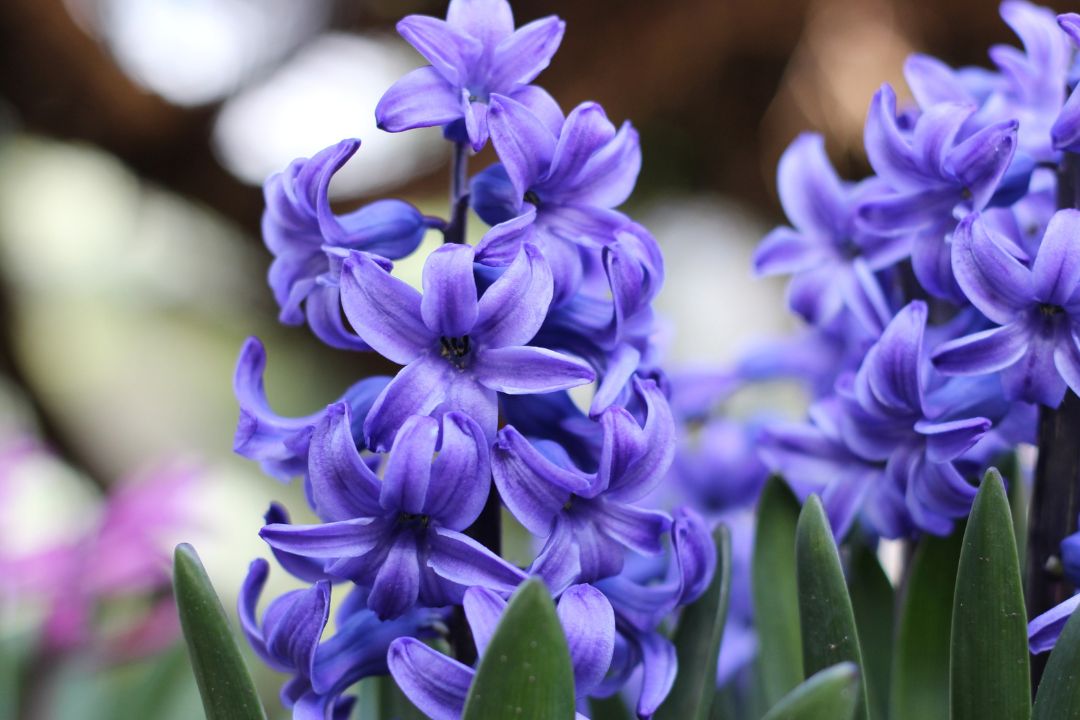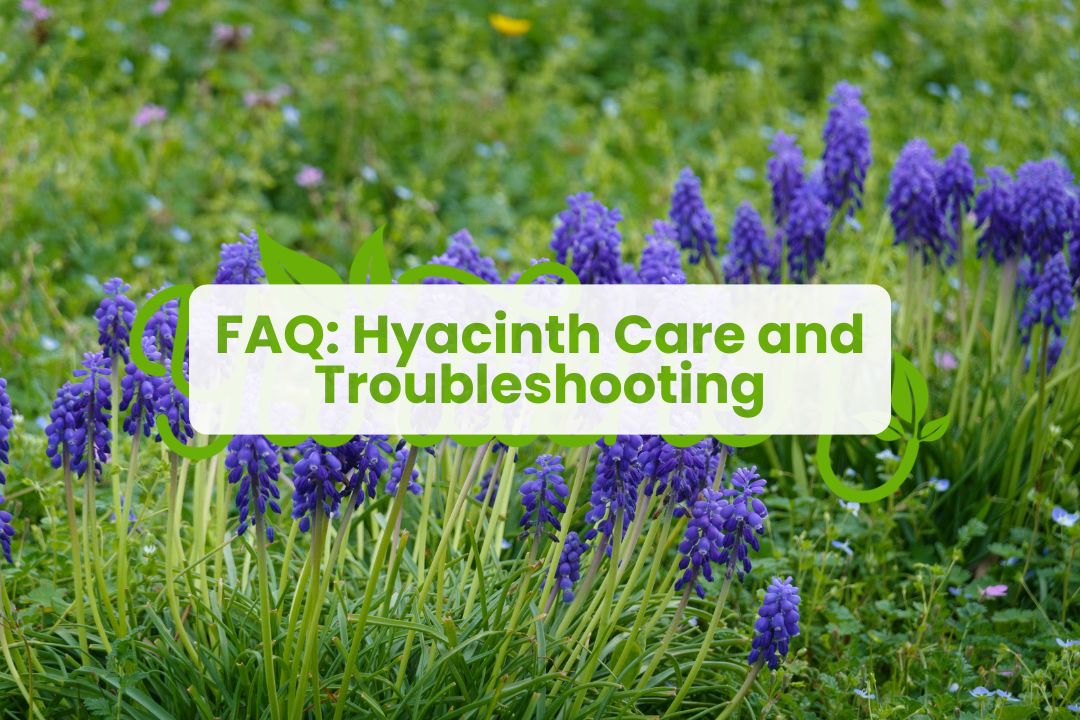Hyacinths are beautiful, fragrant flowers that bring a touch of spring into any space. Whether you're growing them indoors or outdoors, these hardy plants can face a variety of challenges. From pest infestations to environmental stress, understanding common hyacinth problems is crucial to keeping your plants healthy.

In this guide, we'll walk you through the most common issues that affect hyacinths, including indoor hyacinth problems, their symptoms, and the likely causes behind them. With a little care and attention, you'll be able to diagnose and resolve any issues to help your hyacinths thrive season after season.
| Hyacinth Problems | |
|---|---|
| Symptoms | Probable Causes |
| Brown Spots On Leaves and Stems | Frost Injury |
| Stems Weak; Florets Sparse | Bulbs Old |
| Foliage Distorted; Bulbs Decayed | Bulb Mites |
| Bulbs Softened; Plants Yellowed | Narcissus Bulb Fly |
| Plants Stunted; Yellowed; Root Lesions | Bulb Nematodes |
| Foliage And Buds Fail To Open | Aphids |
| Plants Stunted; Die Prematurely | Basal Rot |
| Flowers "Break" In Color; Petals Streaked | Mosaic Virus |
| Bulbs Gnawed; Unearthed Or Eaten | Rodent Injury |
Brown Spots On Leaves and Stems From Frost Injury
Hyacinth leaves and stems touched by late spring frosts may show small brown spots that later merge into blotches. Then, sometimes the leaves split and look ragged. Prevent this by spreading a 2 inch layer of mulch over hyacinth bulbs right after the ground freezes. Hyacinth brown spots are a common symptom of frost injury, so keeping your bulbs insulated helps prevent these unsightly marks.
Stems Weak; Florets Sparse Because Bulbs Are Old
Hyacinths look their best the first season of bloom. While they may come up in subsequent seasons, their blossoms have fewer florets and they are not as stiffly upright. Some homeowners actually prefer them this way. To keep the bulbs in the best possible condition, fertilize bulb beds with bone meal or bulb fertilizer every spring. Be sure to leave the foliage after the blossoms are spent so that it can help the bulb store nutrients for the next season.
Foliage Distorted; Bulbs Decayed Caused By Bulb Mites
Bulb mites, about 1/50 inch long, are almost invisible. They have four pairs of legs, piercing-sucking mouth parts, and very compact bodies. Below ground, they cause the infested hyacinth bulbs to become hard and light chocolate-brown colored. Hundreds of mites feed on their dry and crumbly pulp.
Mite damage also opens the way for other pests and diseases. Hyacinth bugs, such as these mites, can wreak havoc on your plants, causing decay and deformities. Control mites by destroying all affected bulbs. Soak any other dormant bulbs in hot water (110 to 115°F.) for 3 hours.
For more information see the file on Controlling Mites
Bulbs Softened; Plants Yellowed Caused By Narcissus Bulb Fly
This large hairy fly resembles a bumblebee. Its larvae live in bulbs, giving them a spongy texture and causing them to rot. Control these pests by soaking the affected bulbs for 1-1/2 hours in hot water at 110®F. Discard any bulbs that feel soft. When dealing with hyacinth roots, it's essential to inspect for signs of infestation from pests like the narcissus bulb fly, which can weaken the plant's foundation.
Plants Stunted; Yellowed; Root Lesions Caused By Bulb Nematodes
Bulb nematodes and root knot nematodes sometimes attack hyacinths. Nematodes are not insects, but slender, unsegmented roundworms. Most are microscopic-sized soil-dwellers. They have piercing-sucking mouthparts and feed on plant cells. Infested hyacinths look sickly, wilted, and stunted, with yellowed or bronzed foliage.
They decline slowly and die because their root systems are poorly developed, even partially decayed. Bulbs are also damaged. Dig up and trash damaged bulbs. Add lots of compost (especially leaf mold) to the soil to encourage beneficial fungi that attack nematodes.
For more information see the file on Controlling Nematodes
Plants Stunted; Die Prematurely Caused By Basal Rot
This fungus disease attacks hyacinth bulbs when soil temperatures are around 65 to 75°F. To learn more about fungal rot and how to treat it, see the Missouri Botanical Garden’s hyacinth care guide. It stunts plant growth and retards root development. Eventually the bottom of the bulb develops a soft brown rot. Discard any diseased bulbs and avoid injuring healthy ones. Dust bulbs with Benlate before planting them. Dig up bulbs in cool, dry weather, and dry them rapidly. In the event of a serious problem, do not plant hyacinth bulbs in the area for 3 years.
For more information see the file on Controlling Fungal Disease
Flowers "Break" In Color; Petals Streaked Caused By Mosaic Virus
This virus disease causes flower petal color to become streaked. It weakens the hyacinth plant. Mosaic virus is one of several infectious issues common to ornamental bulbs. For a deeper understanding of mosaic virus and other bulb diseases, check this guide from Cornell University's Plant Disease Diagnostic Clinic.
Several kinds of aphids transmit viruses. Trash affected plants. Sterilize any tools used for cutting the flowers in hot water and household bleach to avoid spreading the infection. Control aphids if present, and keep weeds down. Hyacinth bud and flower issues like streaked petals may also be caused by this virus, making it crucial to manage aphid populations effectively.
Bulbs Gnawed; Unearthed Or Eaten From Rodent Injury
During the winter months, small rodents such as mice eat bulbs. Moles tunnel through beds in search of earthworms and insects, then mice or voles use their tunnels to get at hyacinth bulbs. Control these animals by lining your planting holes with small baskets of 1/4-inch hardware cloth cut to fit. Or, try planting individual bulbs in tin can "sleeves" cut open at both ends and sunk into the soil so that the top rim is just beneath the soil surface.
Set the bulbs near the bottom of the can to allow the roots to spread into the soil beneath. On the surface of the soil lay one-inch wire mesh over the bulbs beds and fasten it into the soil with pegs to discourage squirrels and chipmunks from digging up hyacinth bulbs If you suspect hyacinth bulb damage from rodents, this method will help protect your plants.
FAQ: Hyacinth Care and Troubleshooting

What is eating my hyacinth leaves?
If you notice your hyacinth leaves are being eaten, the most likely culprits are hyacinth bugs or other common pests like aphids. Hyacinth bugs are small, often difficult to spot, but they feed on the plant’s leaves, causing damage like discoloration and holes. You might also see other signs of pest activity, such as tiny insects on the leaves or webs, especially from spider mites.
To identify these pests, look for hyacinth bugs feeding on the undersides of leaves, or aphids—tiny, soft-bodied insects that cluster on stems and leaves. Spider mites, which leave webbing on leaves and cause yellow spots, can also cause damage.
To manage or prevent these pests:
- For hyacinth bugs, spray them off with water or apply insecticidal soap to affected areas.
- For aphids, introduce natural predators like ladybugs or use insecticidal soap.
- For spider mites, apply neem oil or horticultural oil to the leaves and increase humidity around the plants to deter them.
By staying proactive and treating pest issues early, you can help keep your hyacinths healthy and thriving.
What are common hyacinth diseases?
Hyacinths are susceptible to a variety of diseases, many of which can impact both the bulbs and the foliage. Common diseases affecting hyacinths include soft rot, leaf blight, powdery mildew, rust, and yellow rot. These diseases often result in stunted growth, discolored leaves, and damaged bulbs. It's crucial to recognize the symptoms early to manage these conditions and maintain healthy plants. Hyacinth roots are particularly vulnerable to certain fungal infections, and issues like hyacinth brown spots are often caused by environmental stress or fungal diseases like frost injury.
Why did my hyacinth not flower?
Hyacinths may fail to bloom for several reasons. If hyacinth buds are not properly formed or if the hyacinth roots are unhealthy, it can prevent flowering.
Here are some specific causes:
- Insufficient chilling time: Hyacinths need a cold period to trigger blooming. If the winter was too warm or short, the bulbs might not have received enough chilling.
- Incorrect planting depth: Planting bulbs too shallow can affect root development, which impacts blooming.
- Overwatering: Too much water can lead to bulb rot, preventing flowers from forming.
- Lack of sunlight: Hyacinths need adequate sunlight for healthy blooming.
- Pest damage: Aphids or other pests can damage hyacinth buds, preventing them from opening.
- Poor bulb quality: Bulbs that are old or poorly stored may have weak or undeveloped flower buds.
To address these issues, ensure your bulbs receive adequate chilling time if you're in a warm climate by pre-chilling them. Plant the bulbs about 3-4 inches deep, ensuring they have room for proper root development. Water your plants appropriately, keeping the soil moist but not soggy, and provide them with enough sunlight. Regularly check for pests and treat them as needed. Always choose healthy, firm bulbs when purchasing to ensure better chances for blooming.
What to do when hyacinth flowers die?
When hyacinth flowers die, it's important to handle them properly to ensure healthy bulbs for the next season. Start by cutting off the spent flower stalk at the base, but leave the foliage intact. Continue watering the plant until the leaves naturally turn yellow and die back, as this process allows the hyacinth bulbs to store energy for the next bloom. After the foliage has died back, you can either plant the bulb outdoors or store it for later use.
Aftercare Steps for Hyacinth Bulbs:
- Cut off the dead flower stalk at the base.
- Leave the foliage until it naturally turns yellow and dies back.
- Continue watering until the foliage has died off completely.
- Once the leaves are dry, plant the bulb outdoors or store it.
- To store the bulbs, carefully remove them, clean off any excess soil, and place them in a cool, dark, dry place in a mesh bag for storage until planting time in the fall.
This care ensures that your hyacinth bulbs will be ready for a strong bloom next season.
Are hyacinths poisonous?
Yes, hyacinths are considered poisonous, particularly their hyacinth bulbs. If ingested, they can cause symptoms such as nausea, vomiting, and diarrhea. The sap from the plant may also irritate the skin, so it's important to handle hyacinths with care. Keep hyacinths out of reach of pets and young children, and wear gloves when handling them to avoid skin irritation.
What are common hyacinth pests?
Hyacinths are vulnerable to a range of pests that can damage both the foliage and the bulbs. Common pests include hyacinth bugs, aphids, spider mites, mealybugs, and bulb mites. These pests can cause various symptoms, such as yellowing leaves, stunted growth, and damaged hyacinth brown spots.
Here's a list of common pests that affect hyacinths and how to manage them:
- Hyacinth Bugs: These insects feed on the plant’s sap, causing leaves to wilt and turn yellow. Regularly inspect plants and remove bugs manually or treat with insecticidal soap.
- Aphids: Small, green insects that suck sap from leaves and stems, causing wilting and discoloration. They also excrete honeydew, which attracts other pests.
- Spider Mites: Tiny pests that suck the life out of leaves, leaving yellow spots and fine webbing. Use insecticidal soap or miticides to control them.
- Mealybugs: These pests feed on sap and can cause stunted growth and discolored, wilted leaves. Regularly remove them by wiping the plant with a cotton ball soaked in alcohol.
- Bulb Mites: These microscopic pests damage the hyacinth bulb, causing it to decay and become soft. Inspect and discard infected bulbs to prevent the spread.
Regularly monitor your plants for these pests, and take action promptly to avoid severe damage.

